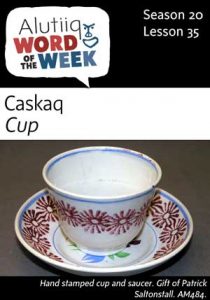 Caskaq–Cup
Caskaq–Cup
Sarsataartukut caskagunk aturluku.–We drink our tea using a cup.
Some historians believe that 1840 was a pivotal moment in Alutiiq history, a point where cultural change accelerated, with major shifts in Kodiak’s social and economic landscape. Devastated by the smallpox epidemic of 1837–1839, Kodiak’s Alutiiq communities reorganized into regional settlements, where survivors began to rebuild their lives. At the same time, Russia and Britain established a formal agreement that allowed the Hudson Bay Company to trade more freely in coastal Alaska, vastly expanding the quantities of western goods available.
Archaeological data illustrate this change. Historic Alutiiq settlements dating before 1840s have few trade goods. Glass beads and copper rings—trinkets from Russian traders with poor links to European supplies—and the occasional fragment of Chinese porcelain occur among assemblages of classical Alutiiq tools. By 1840, however, European ceramics became a common household item. Mid-nineteenth-century Alutiiq villages are filled with fragments of finely made bone china plates, saucers, and teacups. Painted with illustrations from European gardens and cities, they illustrate the dramatic change in the mix of Alutiiq and western objects that characterized this period. While Alutiiq people continued to live in sod houses, their rooms were filled with British teacups, flintlock rifles, iron knives, axes, and other items that began to link them to the global economy. After the American purchase of Alaska, traders brought in cheaper quality ceramics with boldly painted designs.
Source: Alutiiq Museum
[xyz-ihs snippet=”Adsense-responsive”]







